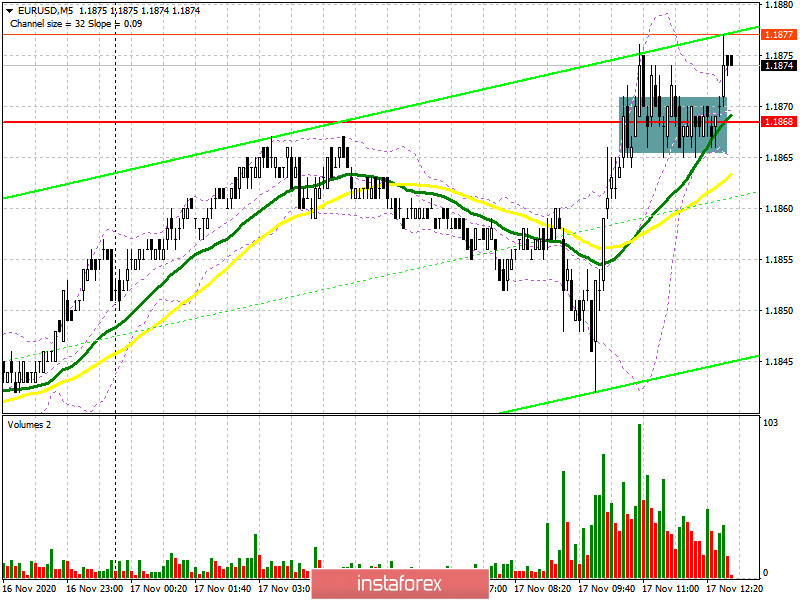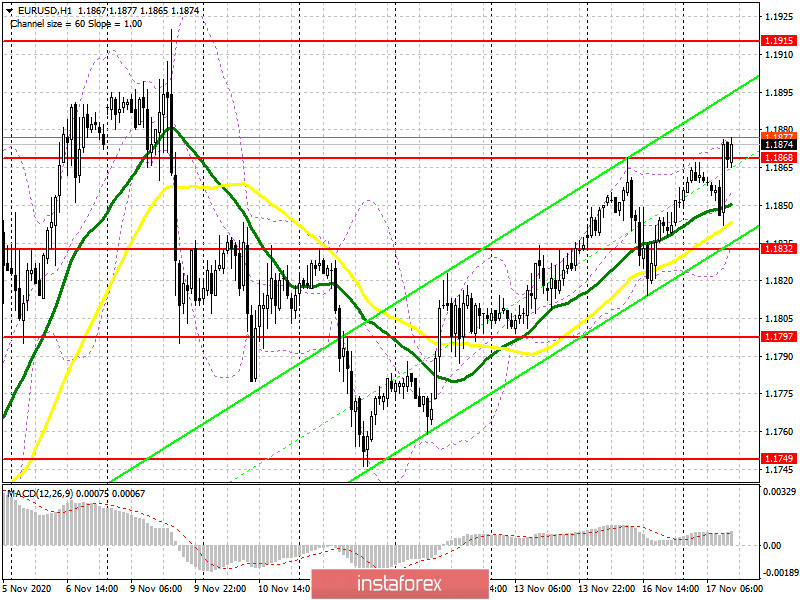To open long positions on EURUSD, you need:
In the first half of the day, a signal was formed to buy the European currency after another attempt by the bulls to get above the resistance of 1.1868. The signal is working at the time of writing. The 5-minute chart clearly shows how the bulls are fixed above 1.1868, which forms the entry point for long positions. Given the fact that important fundamental statistics were not released in the first half of the day, there was no major bullish momentum and, most likely, the entire focus will shift to the second half of the day, when the report on the volume of retail sales in the United States for October this year is released.

As long as trading is conducted above the range of 1.1868, we can expect the euro to continue growing in the short term to update this month's high of 1.1915, where I recommend taking the profits. The level of 1.1964 remains a longer-term goal, however, its test will be real only in case of bad statistics. If the US retail sales data turn out to be much better than economists' forecasts, and EUR/USD returns to the level of 1.1868, gradually forming a base for short positions below this range, it is better to exit purchases and wait for a return to the intermediate support of 1.1832. I recommend opening long positions from this level only after a false breakout is formed. You can buy EUR/USD immediately for a rebound only from the minimum of 1.1797, based on a correction of 15-20 points within the day.
To open short positions on EURUSD, you need:
Sellers are not in a hurry to act actively around the level of 1.1868 and, judging by what is happening, the focus is likely to shift to data on the US economy. A good report will lead to the return of EUR/USD to the level of 1.1868, and its test on the reverse side will form a convenient entry point into short positions in the expectation of a repeated decline in the euro to the support of 1.1832. The further direction of the pair depends on whether this level is broken or not. Fixing below 1.1832 will quickly push the pair to the support of 1.1797, where I recommend fixing the profits. In the scenario of EUR/USD growth further along with the trend that is currently emerging in the market, it is best not to rush with sales, but wait for the resistance test of 1.1915 and sell the euro from there immediately to rebound at the first update. However, the downward movement is unlikely to be more than 10-15 points. A more important task will be to form a false breakout at this level after the bulls' repeated attempt to break above this range. Only this forms a larger downward correction with a return to the area of 1.1868. In the absence of bull activity and the area of 1.1915, short positions in EUR/USD are best postponed until the update of a more recent high of 1.1964, where you can sell the euro immediately for a rebound in the expectation of a correction of 15-20 points within the day.

The COT report (Commitment of Traders) for November 10 recorded a reduction in long and short positions. Euro bulls are holding a wait-and-see attitude and are in no hurry to return to the market even after the presidential election in the United States. But despite this, buyers of risky assets believe in the continuation of the bull market, although they prefer to act cautiously. Thus, long non-commercial positions decreased from 208,237 to 202,374, while short non-commercial positions remained virtually unchanged, falling from 67,888 to 67,087. The total non-commercial net position fell to 135,287 from 140,349 a week earlier. It is worth noting that the delta has been declining for 7 consecutive weeks, which confirms the lack of desire of euro buyers to go to the market in the current conditions. Growth will begin only after Joe Biden's victory and his intentions to give the American economy the next largest monetary aid package for more than $ 2 trillion begin to be realized.
Signals of indicators:
Moving averages
Trading is conducted above 30 and 50 daily moving averages, which indicates an attempt by the bulls to continue pushing the market up.
Note: The period and prices of moving averages are considered by the author on the hourly chart H1 and differ from the general definition of the classic daily moving averages on the daily chart D1.
Bollinger Bands
If the pair declines, the lower limit of the indicator will act as support in the area of 1.1833, the breakout of which will increase the pressure on the pair.
Description of indicators
- Moving average (moving average determines the current trend by smoothing out volatility and noise). Period 50. The graph is marked in yellow.
- Moving average (moving average determines the current trend by smoothing out volatility and noise). Period 30. The graph is marked in green.
- MACD indicator (Moving Average Convergence / Divergence - moving average convergence / divergence) Fast EMA period 12. Slow EMA period 26. SMA period 9
- Bollinger Bands (Bollinger Bands). Period 20
- Non-profit speculative traders, such as individual traders, hedge funds, and large institutions that use the futures market for speculative purposes and meet certain requirements.
- Long non-commercial positions represent the total long open position of non-commercial traders.
- Short non-commercial positions represent the total short open position of non-commercial traders.
- Total non-commercial net position is the difference between the short and long positions of non-commercial traders.





















